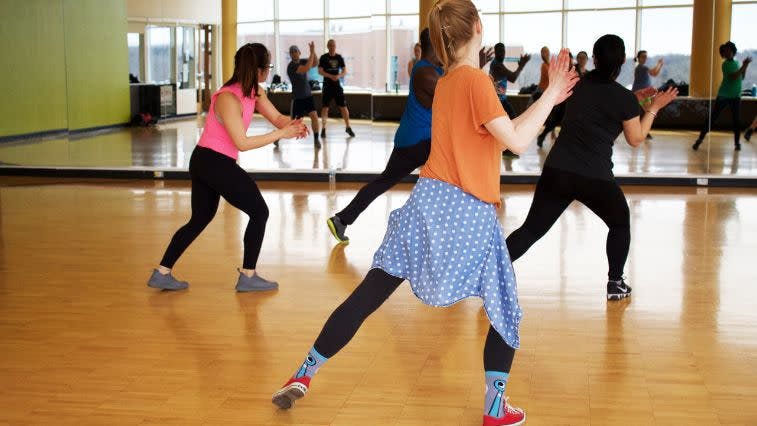How to Lose Weight: Everything You Need to Know to Get Started
Our content strives to support, inform, and motivate you to meet your health goals. We want to be your trusted source of expert- and science-backed info dispensed in simple, actionable ways. Read our Editorial Guidelines.
Making the decision to lose weight is often spurred by an “a-ha!” moment — one that resonates deeply to your core and ignites a flurry of action. It might be inspired by a visit to the doctor’s office that resulted in some not-so-great news, an invitation from friends to go on an epic adventure, or after seeing pictures of yourself and see how much you’ve changed.
My “a-ha!” moment occurred when I realized that none of my clothes were fitting the way they used to. There was even one particular dress, one with a pretty floral pattern that I’d previously worn all the time and felt beautiful in, that wouldn’t zip up anymore. I was determined to shed enough weight to fit back into it, and after six months, I successfully dropped 35 pounds.
Whatever your impetus is, the steps for how to lose weight— and the inevitable obstacles that stand between you and a different number on the scale — remain the same.
The Key Pillars of Weight Loss
Forget everything you’ve heard about fad diets, soul-sucking sacrifices, extreme workouts, and intense restriction. None of these things are required to lose weight, and can in fact work against you in the long run. A healthy life must be sustainable and maintain your sanity, not work against it!
In addition to intrinsic motivation, AKA your “why” for wanting to lose weight, these are the key pillars of weight loss that are within your control:
Good, balanced nutrition
Healthy and enjoyable movement
Mental health, wellbeing, and quality sleep
Accountability
Weaving these pillars into your day life puts you on the path toward success. This requires some light education on topics such as amount and quality of food intake, some experimentation, dabbling in different fitness activities to discover what you like best, and caring for your mental wellbeing.
It’s worth mentioning that some of us may be genetically predisposed to carrying extra weight, but just because one person may be 40–70% more biologically likely to be overweight doesn’t mean they’re destined to become so. Scientific research says obesity is driven by biological and environmental factors. And, we may be able to influence how our genes are expressed by making choices that support healthy weight management.
To that end, be gentle with yourself, focusing on the end-goal versus the inevitable ups and downs of your journey. Equip yourself with cheerleaders, like a personal trainer, nutritionist, and friends, to help keep you on track.
Read more: Why Can’t I Lose Weight? Surprising Reasons Behind the Struggle
Step 1: Evaluate Current Habits & Set Goals
The first step in learning how to lose weight is to hold a mirror up to yourself and take stock of your current habits. After all, the only way we can enact real change is to determine what needs to be changed in the first place.
Acknowledge Unhelpful Habits
Unhelpful habits include anything that gets in the way of your health, happiness, and wellbeing. In other words: negative behavior patterns that aren’t helping you live your best life, or are keeping you from reaching your goals.
“Sometimes it can be scary to let an old habit go,” notes Dr. Haley Perlus, a sports and performance psychologist. “For example, smokers know it’s detrimental to their health, but many view cigarettes as their ‘best friends’ when they know they are their worst enemies.”
In regard to diet and exercise, habits such as snacking on high-calorie sweets at night, remaining sedentary, getting poor sleep, or not observing food portions can all get in the way of our ability to lose weight. Giving up unhelpful habits paves the way for good habits to form.
Read more: What Science Says About the Best Way to Lose Weight
Swap in Good Habits
Finding new behavior patterns to replace the old requires us to chart new and unfamiliar waters. It also means giving up something we derive pleasure from — like snacking or spending hours watching TV or scrolling on our phones — for our ultimate good. This is tricky, but it can be done with consistency, determination, and effort.
“For a positive routine to turn into a good habit, you need to do it enough so that the brain has it on autopilot, like brushing your teeth in the morning,” says Dr. Perlus. “For example, if you chose to make it a habit to wake up every morning and go for a jog, you would want to ensure to set an alarm clock and go to bed at an appropriate time the night before.”
Everyone’s different, but researchers have found that it takes between two-and-a-half weeks to eight months of consistent action to create a new habit.
Personally speaking, I can tell you that it took a good three weeks for me to form new habits during my own weight loss journey. In fact, some of the changes were really difficult to break through, and I had to find a sort of peace in that initial discomfort. That discomfort gave way for a sense of empowerment, though.
For example, I loved snacking at night, but realized that by swapping in higher-protein snacks earlier in the day, I wasn’t as munchy in the evenings. I also swapped seltzer water when I might have had alcohol, and when I did indulge in snacks, I kept it healthy: lightly salted popcorn, yogurt, cottage cheese, or fruit.
Read more: 10 Healthy Habits & How to Automate Them
Step 2: Improve Your Nutrition

Reducing calories (aka calorie restriction) is a science-backed way to lose weight. This strategy involves “spending” more calories than you consume. You can do this intentionally by trying to count calories taken in and calories burned (we’ll get into why this isn’t a precise method in a second), or by trying a variety of diets that, ultimately, lead you to eat fewer calories overall.
While calorie counting is one route you can take, we argue this isn’t the most effective route over the long term.
“Calorie counting can be super tedious to do, whether using an app or a paper log, and it's not always as precise as it seems to be,” explains Registered Dietitian Alexandra Ginos, MBA, RD, CSP. “It's difficult to calculate how many calories each individual person needs on a given day, even for trained clinicians, and food labels are allowed up to 20% variance by the FDA.”
We’re also influenced by imprecise data when trying to calculate how many calories we burn. An article published in the American College of Sports Medicine’s journal notes that most cardio machines overestimate the energy expenditure of exercise, and that the calories burned per minute/hour are off by 1,000-fold. Research shows that fitness trackers (think smartwatches) may also provide unreliable data on calories burned, and different smartwatch brands report different data for calories burned for the same activities.
The most problematic aspect of calorie counting: It can cause some people to become extremely rigid about what they eat, Ginos says. This can create issues with not recognizing/honoring hunger cues, experiencing poor mental health, and feeling overwhelmed to the point of giving up altogether.
Read more: Does Calorie Counting Work for Weight Loss?
As an alternative to rigid calorie counting, consider these options:
Plate Method (MyPlate)
Remember the Food Pyramid Guide created by the USDA? It’s since been replaced with the plate method, also known as MyPlate, as the guideline for healthy eating.
“The idea is that you fill half of your plate at lunch and dinner with vegetables and some fruit, a quarter of your plate with lean protein, and a quarter with a starchy food, like a whole grain,” explains Ginos. She also notes that the USDA's version includes a reminder to include low-fat dairy at meal times.
Food Journal
Another option is to keep a simple food journal. The goal isn’t to be overly tedious or rigid with tracking, but rather to keep a light log of what you’re eating to help you better understand your current food habits. This could even include details like how you felt after eating certain foods, which foods/meals keep you full or seemed to fuel you best, foods that maybe caused a “sugar crash” or “food coma” situation, etc.
Overall Health Focus
Another approach Ginos recommends is to direct your focus to overall diet. When you’re trying to lose weight (and to maintain a healthy weight), research shows that fueling your body with nutrient-dense, protein-rich foods including plenty of fruits and vegetables is a winning strategy. These are the foods that fuel your body and mind, and keep you fuller for longer.
Dietary changes you can make:
Replace refined grains with whole grains
Aim for 1.2–1.5 grams of protein per kilogram of body weight each day, as research supports that higher protein intake can help you lose body fat while preserving lean (muscle) mass
Boost your veggie intake
Curb consumption of “empty calorie” items like alcohol and ultra-processed foods
We’re not saying that you can’t have any refined grains, alcohol, or ultra-processed foods, but rather that you consume small amounts of these in moderation.
“You can think about this when you're building your next meal,” says Ginos. “Make an effort to include a lot of non-starchy veggies at meals — such as summer squash, green beans, kale, carrots, cauliflower, broccoli — and keep portions of proteins and grains to around the size of your palm.” She adds to also make sure you’re treating yourself to some delicious fruit a few times per day as well.
Read more: Simple 7-Day Meal Plan to Lose Weight (Designed by an RD)
One way to help be more mindful of your overall health is to cook the majority of your meals at home — and do some meal planning for all three meals and snacks. Keep healthy, tasty snacks and meals you like stocked at home. Doing all the above can help squash some of those last-minute takeout/delivery orders and fast food swing throughs.
To recap, here are some helpful ways you can curb cravings and improve your nutrition:
Plan meals ahead of time. If possible, plan for the full day or the week.
Cook food at home. This puts control back in your hands.
Have healthy foods and snacks on hand. When you have something healthy and easy to snack on, it’ll make it easier to stay on track with your weight loss goals.
Avoid keeping highly processed foods and desserts you tend to overeat in the house.
Eat slowly, which allows you to pay more attention to feelings of hunger and fullness.
Drink water. Sometimes you’re thirsty instead of hungry, so try a cup of water first. The answer to how much water to drink is enough to fuel your body under the conditions. This is likely about 10 to 15 cups per day.
Write down triggers that cause you to snack or binge. Common culprits include fatigue, extreme hunger, stress, and social situations.
If you’re unsure where to start, work with a dietitian or doctor to discover healthy foods and meal plans to keep you on track.
Read more: An RD’s Advice on How to Start a Diet & What to Avoid
One last word on calories: After you lose weight, you’ll have to eat fewer calories overall to maintain the weight loss because caloric restriction lowers your basal metabolic rate (the amount of energy you burn at rest), reduces the thermic effect of food (how many calories you expend to digest the food you eat), and decreases the energy you spend during exercise.
We’re not telling you this to discourage you, but to commiserate with you (losing weight is hard!) and let you know that maintaining weight lost requires you to keep up the healthy habits you establish during your weight loss journey. You can do this without tunneling down a calorie-counting rabbit hole. Tune into your body’s cues for hunger and satiety (eat until about 80% full), keep an eye on your portions, eat all foods in moderation; and keep up the exercise, quality sleep, and stress management habits.
Read more: It’s Hard to Maintain Weight Loss, But Not Impossible
Step 3: Reframe Your View of Fitness

While good, balanced nutrition is monumental in losing weight, consistent exercise may help you lose more weight than dieting alone. What’s more, research suggests that exercise can help you burn more fat while preserving lean muscle mass. Perhaps most important, though, is that moving our bodies and avoiding a sedentary lifestyle is a key component in our physical health and overall longevity. Research even tells us that exercise is a boon to our mental health.
What to Do if You Dislike Exercise
That said, we understand that fitness isn’t always viewed as a source of joy, which makes many people wonder if they can lose weight without exercise. Instead of looking for an out, though, consider ways you might be able to make fitness something you actually enjoy.
“When embarking on any fitness journey, finding physical activities you enjoy or that are accessible are one of the most important considerations that can influence your trajectory,” says Ruff. “Accessible physical activities you enjoy are more likely to be performed consistently and are also likely to enhance your mood and keep stress levels low.”
Forget everything you dislike about exercise and try something new. If you dread the monotony of an elliptical, you never have to look at one again. If the thought of running makes you want to crawl up in the fetal position and throw away your sneakers, remove the words “5k” and “half marathon” from your vocabulary.
Figure Out What Exercise You Enjoy
Ruff says that a great starting point for finding physical activities you enjoy is to make a quick list of things you’ve tried and either loved or hated. “You can then rate the activities you’ve selected in order of preference and select a couple of favorites,” he says.
This self-assessment also paints a clearer picture of what you haven’t tried yet. Make a second list of things that pique your interest or that you feel confident you could do. Types of exercises to consider:
Walking
Weight lifting
Group fitness classes or hikes
Team sports
Circuit training
Partnered fitness, such as boxing, tennis, or wrestling
Low-impact exercise, such as swimming, Pilates, yoga, and barre
Adventurous fitness, such as snowboarding, mountain biking, or hiking
Read more:8 Tried-and-True Strategies to Make Exercise a Habit That Sticks
Strength Training vs. Cardio

A big debate in the fitness world is whether you should focus on strength training or cardio. Whatever physical activity gets you moving is the ultimate winner, but many people find great success in combining both weight training and heart-pumping cardio.
“Strength training helps build new muscle tissue and bone density. Newly acquired muscle increases our resting metabolic rate, which is how many calories we would burn daily at complete rest,” explains Ruff. “As more new muscle tissue is being built, the body’s metabolic rate continues to climb.”
An increased metabolism from muscle gain over time helps you burn excess body fat, making weight loss easier and giving you a stronger body. Ruff recommends strength training two to three times per week, making sure you target each part of the body.
Cardio also helps you burn excess body fat while keeping your heart and lungs healthy and strong. When starting out, aim for about two to three cardio sessions a week where your heart rate is elevated for at least 20 minutes.
Read more: Your One-week Plan of Best Exercises to Lose Weight, Straight From Fitness Pros
Step 4: Monitor Your Progress
Whatever approach you take, it’s important to make note of your weight loss progress, setbacks, and plateaus along your journey. Here are some approaches you can take:
Daily weigh-in:This accounts for the normal body fluctuations in weight. You’ll see more ups and downs, but the general trajectory will showcase lost weight if you stick with it. Weigh yourself right after you wake up and use the bathroom, and before eating, drinking, or exercising for the most consistent results. Note: If daily weigh-ins become too stressful and you notice any negative emotional side effects, either switch to weekly weigh-ins or pick another method below.
Weekly weigh-in: Daily weigh-ins can feel extreme for some. A weekly weigh-in will give you a snapshot of the week, but keep in mind you may weigh in on an abnormally high-weight day caused by something like a hard workout, hormone fluctuations, or sodium-dense meal. Pick the same day to weigh yourself each week, and do so after you wake up and use the bathroom and before doing anything else.
Measurements: If the scale isn’t for you, you can track your weight loss progress via measurements. At the beginning of your journey, measure key parts of the body — such as the upper arm, stomach, and thighs – and re-measure every two to four weeks.
Pictures: Simple before-and-after images are another way to monitor your progress without needing a scale. These images can show you how much your body has changed, even if the scale itself doesn’t move much.
Clothing: Take note of how you feel in certain clothes, and whether you can fit into certain garments. Putting these clothing items on throughout your journey and assessing how they fit can give you a good idea of your weight loss over time.
Whatever method you prefer, it’s important to keep track of your trajectory so you can adjust as needed and celebrate your wins. Monitoring your progress helps formulate a “story” about your body’s response to your food intake and exercise plan.
Step 5: Avoid the Temptation to Slip Back Into Old Habits

As motivated as you are during that “a-ha!” moment, life has a tendency of, well, getting in your way. You may find yourself in the middle of a busy work week or month that causes you to push your fitness goals aside, or perhaps you’ve hit a plateau and are feeling uninspired.
“People tend to fall back on old habits because they’re familiar crutches,” notes Dr. Perlus. She adds that in many cases, we also associate these less-healthy habits with a sense of (short-lived) pleasure, which makes them all the more tempting. Here are some ways you can avoid slipping back into old habits:
Tap Into Your “Why”: Success is more likely when we’re deeply, personally motivated to change. Meditate on that “a-ha!” moment that triggered your desire to lose weight, and hold it close.
Give Yourself Some Slack: No weight loss journey is without valleys. “When on a nutrition journey, some days are weight loss days, weight maintenance, and occasionally a weight gain day if there is a celebration,” notes Dr. Perlus. “If you do indulge, don't get stuck in it. Own it and move forward. Start the next day fresh.” According to the transtheoretical model, our journeys are never linear paths. Consider those valleys part of the natural journey toward change.
Find Joy in Your Journey: Aggressive restriction, fad diets, and unsustainable routines suck the joy out of losing weight and getting healthy. Find joy in fueling your body with colorful, nutrient-dense foods. Get excited about a new fitness class or your morning walk versus “torturing” yourself with exercise you don't find enjoyable.
Nurture Your Mental Health and Wellbeing: Make sure you’re taking care of your body and mind. Prioritize a good bedtime routine so you get ample sleep each night, avoid overcommitting yourself, and put your wellbeing above other obligations.
Enlist Experts to Hold You Accountable: Our own willpower is finite, and you may find that your motivation wanes weeks or months into your weight loss journey. This is where personal cheerleaders can help. If your budget allows, work alongside a personal trainer, nutritionist, or health coach who can educate, motivate, and guide you along the way. Research tells us that these social supports are crucial for reaching our goals.
Read more: Why We Need Human Accountability to Achieve Our Goals
Celebrate Successes Along the Way: Take pause to give yourself a pat on the back anytime you hit a milestone. That might be hitting the gym for the first time, logging your food for a week, or losing five pounds. These are the stepping stones toward big success, and acknowledging them will help keep you motivated. Remember that tomorrow will come, next month will arrive, and a year will pass. How are you going to spend that time between now and then? To help ignite your journey and keep yourself motivated, consider a free consultation with a personal trainer who can teach you how to lose weightand be your cheerleader along the way. Sources:
Lally P, van Jaarsveld CHM, Potts HWW, Wardle J. How are habits formed: Modelling habit formation in the real world. Eur J Soc Psychol. 2010;40(6):998-1009.
“Healthy eating for a healthy weight.” Centers for Disease Control and Prevention. https://www.cdc.gov/healthyweight/healthy_eating/index.html
“How much water do you need to stay healthy?” Mayo Clinic. https://www.mayoclinic.org/healthy-lifestyle/nutrition-and-healthy-eating/in-depth/water/art-20044256
“Physical activity for a healthy weight.” Centers for Disease Control and Prevention. https://www.cdc.gov/healthyweight/physical_activity/index.html
Single-cell dissection of the obesity-exercise axis in adipose-muscle tissues implies a critical role for mesenchymal stem cells. Cell Metabolism. 2022;34(10):1578-1593.e6.
Chekroud SR, Gueorguieva R, Zheutlin AB, et al. Association between physical exercise and mental health in 1·2 million individuals in the USA between 2011 and 2015: a cross-sectional study. The Lancet Psychiatry. 2018;5(9):739-746.
Pirzadeh, A., Mostafavi, F., Ghofranipour, F., & Feizi, A. (2015). Applying transtheoretical model to promote physical activities among women. Iranian Journal of Psychiatry and Behavioral Sciences, 9(4), e1580. https://doi.org/10.17795/ijpbs-1580
Oussedik, E., Foy, C. G., Masicampo, E. J., Kammrath, L. K., Anderson, R. E., & Feldman, S. R. (2017). Accountability: A missing construct in models of adherence behavior and in clinical practice. Patient Preference and Adherence, 11, 1285–1294.